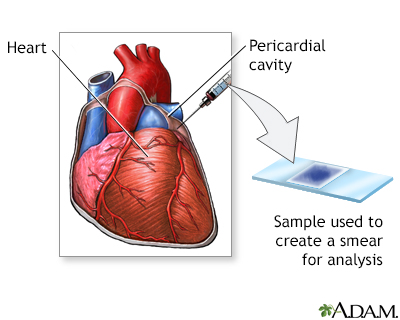Pericardial fluid culture
Culture - pericardial fluid
Pericardial fluid culture is a test performed on a sample of fluid from the sac surrounding the heart. It is done to identify organisms that cause infection.
Pericardial fluid Gram stain is a related topic.
Images


I Would Like to Learn About:
How the Test is Performed
Some people may have a cardiac monitor placed before the test to check for heart disturbances. Patches called electrodes will be placed on the chest, similar to during an ECG. A chest x-ray or ultrasound may be done before the test.
The skin of the chest will be cleaned with antibacterial soap. A health care provider inserts a small needle into the chest between the ribs into the thin sac that surrounds the heart (the pericardium). A small amount of fluid is removed.
You may have an ECG and chest x-ray after the test. Sometimes the pericardial fluid is taken during open heart surgery.
The sample is sent to a lab. Samples of the fluid are placed on dishes of growth media to see if bacteria grow. It can take a few days to several (6 to 8) weeks to get the test results.
How to Prepare for the Test
You will be asked to not eat or drink anything for several hours before the test. You may have a chest x-ray or ultrasound before the test to identify the area of fluid collection.
How the Test will Feel
You will feel some pressure and discomfort when the needle is inserted into the chest and the fluid is removed. Your provider should be able to give you pain medicine so that the procedure does not hurt very much.
Why the Test is Performed
Your provider may order this test if you have a heart infection (myocarditis), signs of a heart sac infection, or a pericardial effusion (fluid buildup of the pericardium) with an unknown cause.
The test may also be done if you have or are suspected to have pericarditis.
Normal Results
A normal result means no bacteria or fungi are found in the fluid sample.
What Abnormal Results Mean
Abnormal results may be due to an infection of the pericardium. The specific organism causing the infection may be identified. More tests may be needed to determine the most effective treatments.
Risks
Complications are rare but include:
- Heart or lung puncture
- Infection
Related Information
PericarditisReferences
Banks AZ, Corey GR. Myocarditis and pericarditis. In: Cohen J, Powderly WG, Opal SM, eds. Infectious Diseases. 4th ed. Philadelphia, PA: Elsevier; 2017:446-455.
LeWinter MM, Cremer PC, Klein AL. Pericardial diseases. In: Libby P, Bonow RO, Mann DL, Tomaselli GF, Bhatt DL, Solomon SD, eds. Braunwald's Heart Disease: A Textbook of Cardiovascular Medicine. 12th ed. Philadelphia, PA: Elsevier; 2022:chap 86.
Maisch B, Ristic AD. Pericardial diseases. In: Vincent JL, Moore FA, Bellomo R, Marini JJ, eds. Textbook of Critical Care. 8th ed. Philadelphia, PA: Elsevier; 2024:chap 75.
Patel R. The clinician and the microbiology laboratory: test ordering, specimen collection, and result interpretation. In: Bennett JE, Dolin R, Blaser MJ, eds. Mandell, Douglas, and Bennett's Principles and Practice of Infectious Diseases. 9th ed. Philadelphia, PA: Elsevier; 2020:chap 16.
BACK TO TOPReview Date: 12/4/2022
Reviewed By: Jatin M. Vyas, MD, PhD, Associate Professor in Medicine, Harvard Medical School; Associate in Medicine, Division of Infectious Disease, Department of Medicine, Massachusetts General Hospital, Boston, MA. Also reviewed by David C. Dugdale, MD, Medical Director, Brenda Conaway, Editorial Director, and the A.D.A.M. Editorial team.

Health Content Provider
06/01/2025
|
A.D.A.M., Inc. is accredited by URAC, for Health Content Provider (www.urac.org). URAC's accreditation program is an independent audit to verify that A.D.A.M. follows rigorous standards of quality and accountability. A.D.A.M. is among the first to achieve this important distinction for online health information and services. Learn more about A.D.A.M.'s editorial policy, editorial process and privacy policy. A.D.A.M. is also a founding member of Hi-Ethics. This site complied with the HONcode standard for trustworthy health information from 1995 to 2022, after which HON (Health On the Net, a not-for-profit organization that promoted transparent and reliable health information online) was discontinued. |
The information provided herein should not be used during any medical emergency or for the diagnosis or treatment of any medical condition. A licensed medical professional should be consulted for diagnosis and treatment of any and all medical conditions. Links to other sites are provided for information only -- they do not constitute endorsements of those other sites. © 1997- 2024 A.D.A.M., a business unit of Ebix, Inc. Any duplication or distribution of the information contained herein is strictly prohibited.
